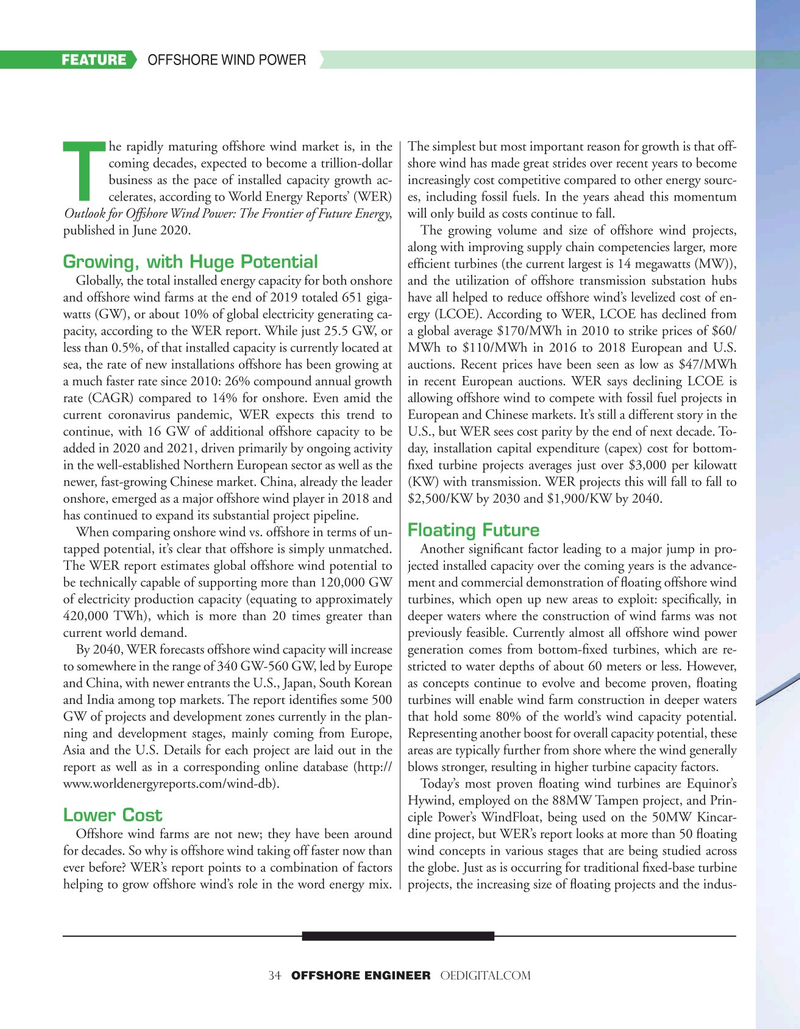
Page 34: of Offshore Engineer Magazine (May/Jun 2020)
Read this page in Pdf, Flash or Html5 edition of May/Jun 2020 Offshore Engineer Magazine
FEATURE OFFSHORE WIND POWER he rapidly maturing offshore wind market is, in the The simplest but most important reason for growth is that off- coming decades, expected to become a trillion-dollar shore wind has made great strides over recent years to become business as the pace of installed capacity growth ac- increasingly cost competitive compared to other energy sourc-
T celerates, according to World Energy Reports’ (WER) es, including fossil fuels. In the years ahead this momentum
Outlook for Offshore Wind Power: The Frontier of Future Energy, will only build as costs continue to fall.
published in June 2020. The growing volume and size of offshore wind projects, along with improving supply chain competencies larger, more effcient turbines (the current largest is 14 megawatts (MW)),
Growing, with Huge Potential
Globally, the total installed energy capacity for both onshore and the utilization of offshore transmission substation hubs and offshore wind farms at the end of 2019 totaled 651 giga- have all helped to reduce offshore wind’s levelized cost of en- watts (GW), or about 10% of global electricity generating ca- ergy (LCOE). According to WER, LCOE has declined from pacity, according to the WER report. While just 25.5 GW, or a global average $170/MWh in 2010 to strike prices of $60/ less than 0.5%, of that installed capacity is currently located at MWh to $110/MWh in 2016 to 2018 European and U.S. sea, the rate of new installations offshore has been growing at auctions. Recent prices have been seen as low as $47/MWh a much faster rate since 2010: 26% compound annual growth in recent European auctions. WER says declining LCOE is rate (CAGR) compared to 14% for onshore. Even amid the allowing offshore wind to compete with fossil fuel projects in current coronavirus pandemic, WER expects this trend to European and Chinese markets. It’s still a different story in the continue, with 16 GW of additional offshore capacity to be U.S., but WER sees cost parity by the end of next decade. To- added in 2020 and 2021, driven primarily by ongoing activity day, installation capital expenditure (capex) cost for bottom- in the well-established Northern European sector as well as the fxed turbine projects averages just over $3,000 per kilowatt newer, fast-growing Chinese market. China, already the leader (KW) with transmission. WER projects this will fall to fall to onshore, emerged as a major offshore wind player in 2018 and $2,500/KW by 2030 and $1,900/KW by 2040. has continued to expand its substantial project pipeline.
Floating Future
When comparing onshore wind vs. offshore in terms of un- tapped potential, it’s clear that offshore is simply unmatched. Another signifcant factor leading to a major jump in pro-
The WER report estimates global offshore wind potential to jected installed capacity over the coming years is the advance- be technically capable of supporting more than 120,000 GW ment and commercial demonstration of foating offshore wind of electricity production capacity (equating to approximately turbines, which open up new areas to exploit: specifcally, in 420,000 TWh), which is more than 20 times greater than deeper waters where the construction of wind farms was not current world demand. previously feasible. Currently almost all offshore wind power
By 2040, WER forecasts offshore wind capacity will increase generation comes from bottom-fxed turbines, which are re- to somewhere in the range of 340 GW-560 GW, led by Europe stricted to water depths of about 60 meters or less. However, and China, with newer entrants the U.S., Japan, South Korean as concepts continue to evolve and become proven, foating and India among top markets. The report identifes some 500 turbines will enable wind farm construction in deeper waters
GW of projects and development zones currently in the plan- that hold some 80% of the world’s wind capacity potential. ning and development stages, mainly coming from Europe, Representing another boost for overall capacity potential, these
Asia and the U.S. Details for each project are laid out in the areas are typically further from shore where the wind generally report as well as in a corresponding online database (http:// blows stronger, resulting in higher turbine capacity factors.
www.worldenergyreports.com/wind-db). Today’s most proven foating wind turbines are Equinor’s
Hywind, employed on the 88MW Tampen project, and Prin-
Lower Cost ciple Power’s WindFloat, being used on the 50MW Kincar-
Offshore wind farms are not new; they have been around dine project, but WER’s report looks at more than 50 foating for decades. So why is offshore wind taking off faster now than wind concepts in various stages that are being studied across ever before? WER’s report points to a combination of factors the globe. Just as is occurring for traditional fxed-base turbine helping to grow offshore wind’s role in the word energy mix. projects, the increasing size of foating projects and the indus- 34 OFFSHORE ENGINEER OEDIGITAL.COM

 33
33

 35
35